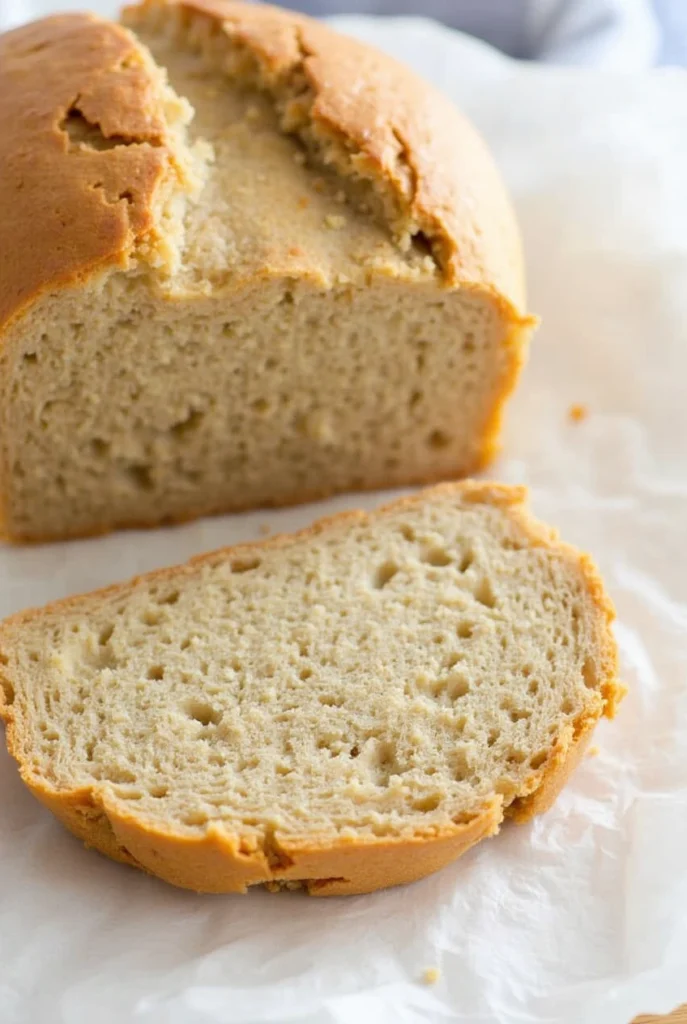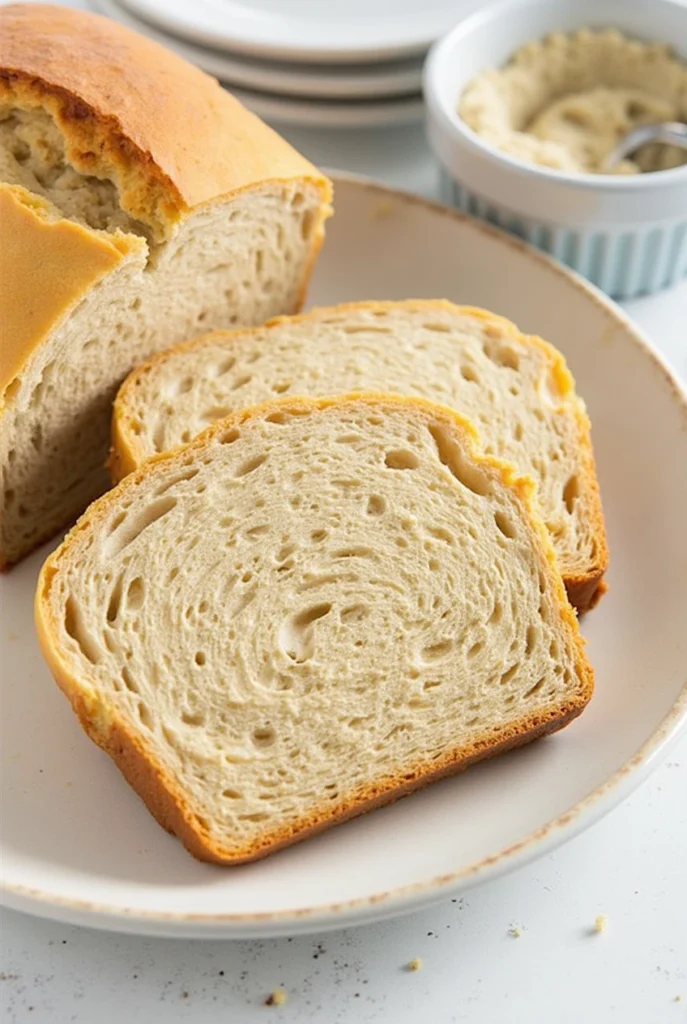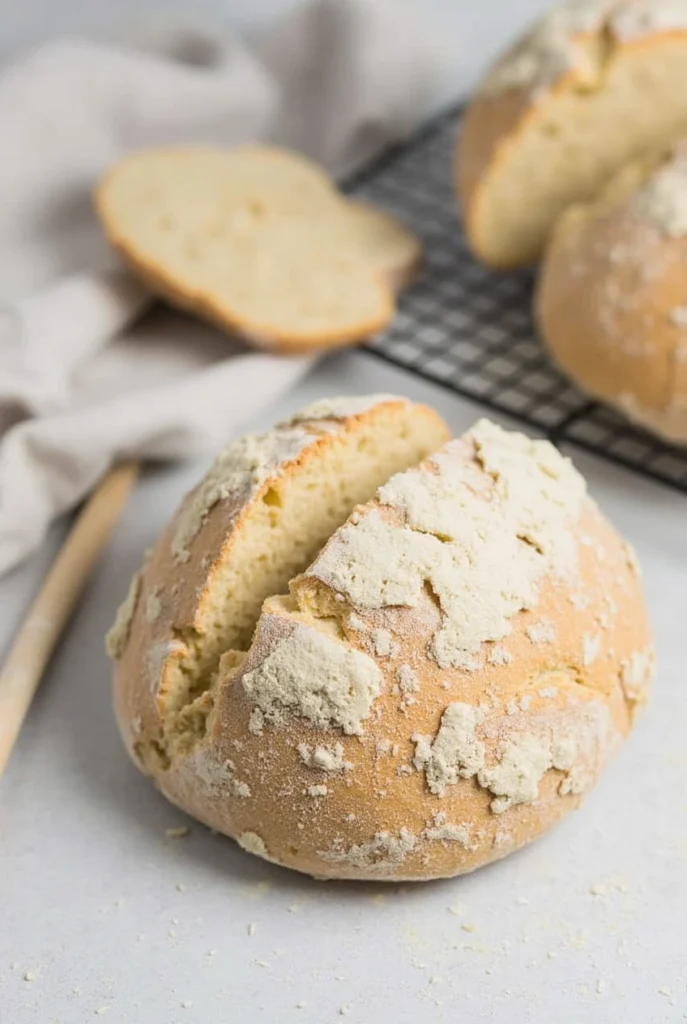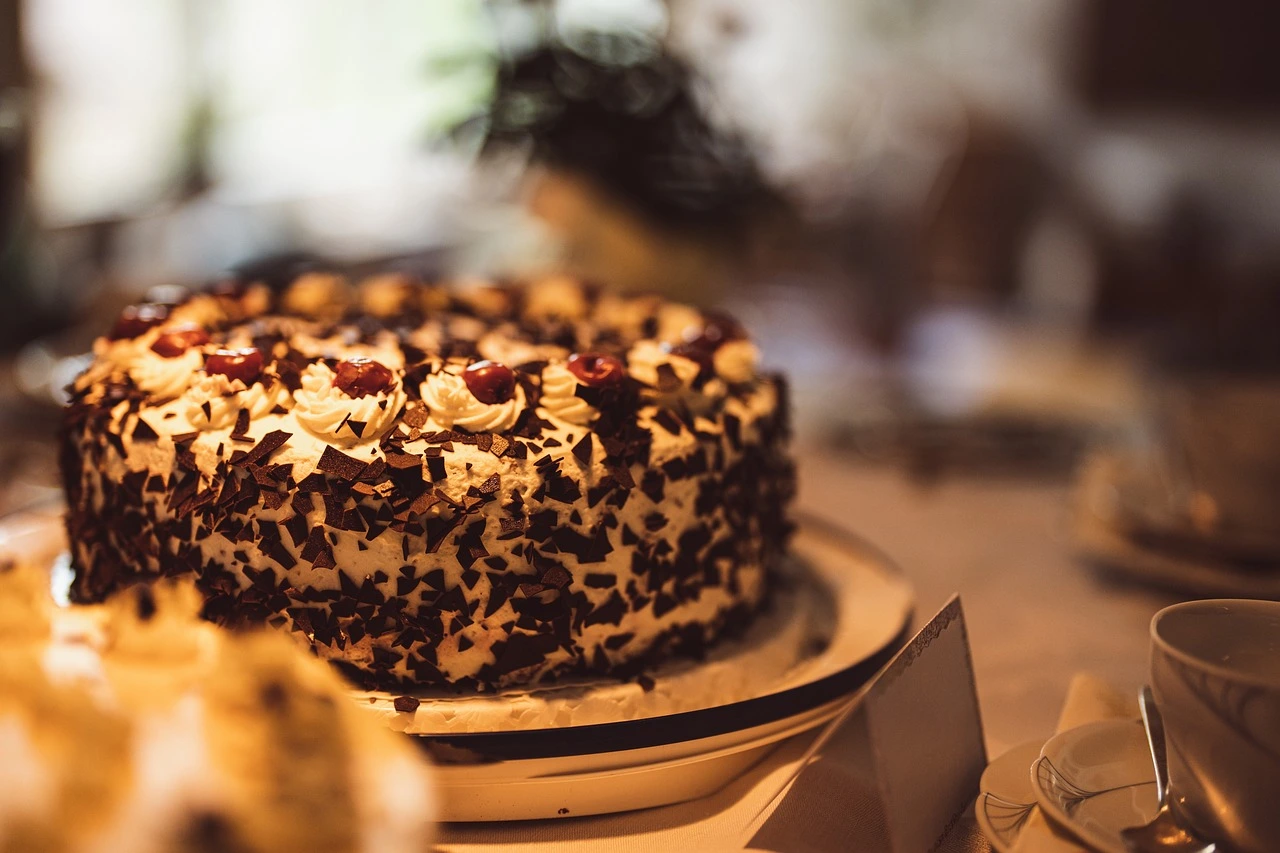Table of Contents
There’s something deeply satisfying about the gentle rhythm of sourdough baking – feeding your starter, watching it bubble with life, and crafting beautiful loaves. But that rhythm comes with a byproduct: sourdough discard. If you’ve ever felt a twinge of guilt tossing that tangy mixture down the drain, this sourdough discard bread recipe will change your baking game forever. Using your discard isn’t just economical; it brings unique flavor dimensions that make this bread special in its own right.

Ingredients List
For this wonderfully fragrant and tangy sourdough discard bread recipe, gather these ingredients:
- 1 cup (240g) sourdough discard (straight from the refrigerator is fine)
- 3½ cups (420g) all-purpose flour (King Arthur works exceptionally well)
- 1½ cups (360ml) warm water (about 95°F/35°C)
- 2 tablespoons (28g) unsalted butter, softened (or olive oil for a dairy-free option)
- 1 tablespoon (12g) granulated sugar (honey makes a lovely substitute)
- 2¼ teaspoons (7g) active dry yeast (1 standard packet)
- 1½ teaspoons (9g) salt (sea salt brings a subtle mineral quality)
- 1 tablespoon (15ml) white vinegar (enhances the sourdough flavor)
The ingredients blend together to create a symphony of flavors – the tanginess from your discard combining with the subtle sweetness from the sugar, while the vinegar amplifies the sourdough notes that might otherwise be muted in a quicker bread recipe.

Timing
This sourdough discard bread recipe respects your time while delivering outstanding results:
- Preparation time: 20 minutes (35% less hands-on time than traditional sourdough)
- Rising time: 1 hour 30 minutes (divided into two rises)
- Baking time: 35-40 minutes
- Total time: Approximately 2 hours 30 minutes
What makes this timing remarkable is that you’ll achieve sourdough-like flavor in less than half the time of a traditional sourdough loaf, which typically requires 12-24 hours from start to finish. This efficiency doesn’t compromise quality – rather, it harnesses the best of both worlds: complex flavor from your discard and reliable rise from the added yeast.
Step-by-Step Instructions
Step 1: Activate Your Yeast
In a large mixing bowl, combine the warm water (95°F/35°C) with sugar and active dry yeast. Stir gently and let it sit for about 6-10 minutes until frothy. This activation step ensures your bread will rise properly and creates a foundation of reliable fermentation that complements your sourdough discard’s wild yeasts.
Pro tip: If your yeast doesn’t foam after 10 minutes, it may be inactive. Better to start fresh than risk a dense loaf!
Step 2: Mix Wet Ingredients
Once your yeast is happily bubbling, stir in your sourdough discard until well combined. The mixture might look slightly curdled or uneven – that’s perfectly normal! Add the softened butter (or olive oil) and white vinegar, whisking until incorporated. You’re creating a rich base that will carry the signature sourdough flavor throughout your finished loaf.
For an extra dimension of flavor, try brown butter instead of regular – the nutty notes complement the tang beautifully.
Step 3: Incorporate Dry Ingredients
Add the flour and salt to your wet mixture, starting with 3 cups of flour. Using a wooden spoon or stand mixer with a dough hook, mix until a shaggy dough forms. Gradually add the remaining ½ cup of flour as needed until the dough pulls away from the sides of the bowl but still feels slightly tacky.
Your touch matters here – the perfect dough should feel alive under your fingers, slightly sticky but not wet.
Step 4: Knead the Dough
Turn the dough onto a lightly floured surface and knead for 5-7 minutes until smooth and elastic. The dough should pass the “window pane test” – when stretched between your fingers, it should become thin enough to see light through without tearing.
This kneading develops gluten structure that your discard alone wouldn’t have achieved in this shorter timeframe, ensuring a satisfying chew in your finished bread.
Step 5: First Rise
Place your dough in a lightly oiled bowl, turning once to coat. Cover with a damp kitchen towel or plastic wrap and let rise in a warm spot until doubled in size, approximately 45-60 minutes.
Temperature matters more than time – around 75-80°F (24-27°C) is ideal. On colder days, turn your oven on for 1 minute, then turn it off and place the dough inside with the door closed to create a perfect rising environment.
Step 6: Shape the Loaf
Gently punch down the dough to release excess air bubbles. Shape into your desired form – a round boule, an oval batard, or place in a standard 9×5-inch loaf pan for sandwich bread. If making a free-form loaf, place on a parchment-lined baking sheet or in a floured banneton basket.
The shaping technique influences not just appearance but crumb structure – a tightly shaped loaf yields a more uniform crumb ideal for sandwiches, while a looser shape creates more air pockets.
Step 7: Second Rise
Cover your shaped dough and allow it to rise again for 30-45 minutes until visibly puffy. About 20 minutes before baking, preheat your oven to 424°F (220°C). If using a Dutch oven.
This second rise is shorter but crucial – it builds the final volume without exhausting the yeast’s lifting power.
Step 8: Score and Bake
Just before baking, score the top of your loaf with a sharp knife or bread lame, creating a design that’s both functional (allowing for expansion) and beautiful. If using a Dutch oven, carefully transfer your dough to the preheated pot, cover, and bake for 20 minutes. Then remove the lid and continue baking for 15-20 minutes more until deeply golden brown and the internal temperature reaches 200-205°F (93-96°C).
If baking on a sheet pan, consider adding a tray of ice cubes to the bottom of the oven when you put the bread in – this creates steam that helps develop a crackling crust.
Step 9: Cool Completely
Here’s where patience becomes a virtue – allow your bread to cool completely on a wire rack for at least 1 hour before slicing. Cutting too soon releases steam and can result in a gummy texture, undoing all your hard work.
The cooling period isn’t just practical – it’s when the flavor continues developing and the crumb structure sets.

Nutritional Information
Per slice (based on 16 slices per loaf):
- Calories: 145
- Carbohydrates: 27g
- Protein: 4g
- Fat: 2g
- Fiber: 1g
- Sodium: 220mg
This sourdough discard bread recipe provides approximately 12% of your daily recommended grain intake per slice, making it a nutritious choice compared to many store-bought alternatives that contain preservatives and excess sodium.
Healthier Alternatives for the Recipe
Make this sourdough discard bread recipe even more nutritious with these thoughtful modifications:
- Substitute up to half of the all-purpose flour with whole wheat flour for increased fiber (note: you may need to add 1-2 extra tablespoons of water)
- Add 3 tablespoons of ground flaxseed or chia seeds for omega-3 fatty acids
- Reduce the sugar to 1 teaspoon if preferred – the discard provides natural sweetness
- Incorporate 1/4 cup of pumpkin seeds, sunflower seeds, or chopped walnuts for texture and nutrition
- Replace butter with extra virgin olive oil or avocado oil for heart-healthy fats
These alternatives maintain the bread’s delicious flavor profile while enhancing its nutritional value, making each slice work harder for your health without sacrificing the comfort of homemade bread.
Serving Suggestions
Transform your sourdough discard bread from simple to spectacular with these serving ideas:
- Toast thick slices and top with mashed avocado, flaky sea salt, and red pepper flakes for a trendy breakfast
- Use as the foundation for the ultimate grilled cheese sandwich – the tangy bread complements sharp cheddar beautifully
- Cube leftover bread, toss with olive oil and herbs, and bake for homemade croutons that elevate any salad
- Create an impressive crostini appetizer board with various toppings like ricotta and honey or tomato bruschetta
- French toast made with this bread delivers a subtle sourdough tang that pairs wonderfully with maple syrup
For an extraordinary experience, serve a warm slice with cultured butter and flaky salt – the simplicity allows the bread’s complex flavors to shine.
Common Mistakes to Avoid
Even experienced bakers can trip up on a sourdough discard bread recipe. Here’s how to navigate potential pitfalls:
- Using very old discard (over 2 weeks) may introduce excessive acidity – if your discard is extra old, reduce to 3/4 cup and add 1/4 cup water plus 1/4 cup flour
- Overproofing the dough can lead to collapse – the second rise is complete when pressing the dough gently leaves an indentation that slowly fills halfway back in
- Under-kneading results in poor structure – data shows that 5-7 minutes of proper kneading develops optimal gluten formation
- Using cold ingredients slows yeast activity – ensure all components (except the discard) are at room temperature
- Cutting into the bread too soon releases steam that’s still cooking the interior – resist the temptation!
According to baking science, temperature variations as small as 5°F can significantly impact fermentation rates, so pay attention to your environment and adjust accordingly.
Storing Tips for the Recipe
Maximize the lifespan and quality of your sourdough discard bread with these storage methods:
- Store at room temperature in a bread box or paper bag for 2-3 days to maintain crust integrity
- For longer storage, slice the cooled loaf completely and freeze in a zip-top bag with air removed – individual slices can be toasted directly from frozen
- Avoid refrigerating your bread, as this accelerates staling through a process called retrogradation
- If the crust softens during storage, refresh the loaf in a 350°F (175°C) oven for 5-10 minutes
- To revive slightly stale bread, sprinkle with water and warm in the oven for 5-7 minutes – it works wonders!
For the best eating experience, consider baking smaller loaves more frequently rather than storing one large loaf for an extended period – research shows freshness perception decreases by approximately 40% after the second day.
Conclusion
This sourdough discard bread recipe transforms what would be waste into wonderful flavor. By combining the tang of discard with reliable yeasted bread techniques, you’ll create a loaf that’s both practical and delicious. Try this recipe today, share your results in the comments, and subscribe for more sustainable baking tips!
FAQs
Can I use discard straight from the refrigerator? Yes! Unlike regular sourdough bread that requires an active, bubbly starter, this recipe works perfectly with cold discard. The added yeast provides the necessary leavening power.
How long can I keep sourdough discard before using it in this recipe? Discard stored in the refrigerator remains usable for 1-2 weeks. Beyond that, it may become excessively acidic, though still safe to use. For very old discard, reduce the quantity and adjust with fresh flour and water.
Can I make this recipe without commercial yeast? While possible, it would require an active discard and much longer fermentation time. The beauty of this recipe is its reliability and speed compared to traditional sourdough.
Is this bread suitable for beginners? Absolutely! This forgiving recipe bridges the gap between regular yeasted bread and full sourdough, making it perfect for those new to sourdough baking.
How can I make my bread more sour? For increased tanginess, use older discard (7-10 days old), increase the vinegar to 2 tablespoons, or add 1/4 teaspoon of citric acid to the dough.
Can I make this recipe dairy-free? Yes! Simply substitute the butter with olive oil, coconut oil, or another plant-based fat of your choice.
How do I know when my bread is properly baked? The most reliable method is checking the internal temperature with an instant-read thermometer – it should register 200-205°F (93-96°C). Alternatively, the bottom of the loaf should sound hollow when tapped.







